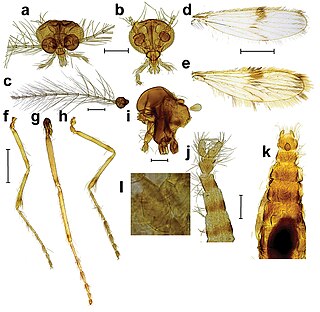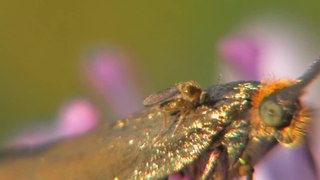
A midge is any small fly, including species in several families of non-mosquito Nematoceran Diptera. Midges are found on practically every land area outside permanently arid deserts and the frigid zones. Some midges, such as many Phlebotominae and Simuliidae, are vectors of various diseases. Many others play useful roles as prey for insectivores, such as various frogs and swallows. Others are important as detritivores, and form part of various nutrient cycles. The habits of midges vary greatly from species to species, though within any particular family, midges commonly have similar ecological roles.

The Nematocera are a suborder of elongated flies with thin, segmented antennae and mostly aquatic larvae. This group is paraphyletic and contains all flies but species from suborder Brachycera, which includes more commonly known species as housefly or the common fruit fly. Families in Nematocera include mosquitoes, crane flies, gnats, black flies, and a multiple groups of families described as midges. The Nematocera typically have fairly long, fine, finely-jointed antennae. In many species, such as most mosquitoes, the female antennae are more or less threadlike, but the males have spectacularly plumose antennae.

Ceratopogonidae is a family of flies commonly known as no-see-ums, or biting midges, generally 1–3 millimetres in length. The family includes more than 5,000 species, distributed worldwide, apart from the Antarctic and the Arctic.

The Perissommatidae are a family of flies (Diptera) that was proposed in 1962 by Donald Colless based on the species Perissomma fusca from Australia. The family now includes five extant species within the single genus Perissomma, four from Australia and one from Chile. The Perissommatidae are unusual as they appear to have four compound eyes. They have a small slender body less than 2 mm in length. Their wings are large in comparison to their bodies and subsequently their flight is weak. Preferring high-altitude forest environments, adults only fly in the winter. The larvae live in decaying leaf litter in wet sclerophyll or cool rain forests. Some species are suspected to be associated with fungi. In the case of Perissomma macalpinei, numbers of adults have been observed congregating in clumps of foliage and rising in short, zigzag flights in the sunlight above the foliage for short periods before descending.
Arctodiamesa is a genus of non-biting midges in the subfamily Diamesinae of the bloodworm family Chironomidae.

Corethrellidae are a family of biting midges, small flying insects belonging to the order Diptera, females of which feed on the blood of frogs. The members of the family are sometimes known as frog-biting midges. The family currently consists of just one genus, totalling 115 extant and 10 fossil species worldwide. Most extant species are found in the lower latitudes, usually associated around the tropics.

Corethrella is a genus of midges that are classified in the family Corethrellidae.

Leptoconops is a midge genus in the family Ceratopogonidae. It has a mostly tropical or subtropical distribution worldwide, but some species occur as far north as Moscow region in Russia and the Yukon Territory in Canada.

Forcipomyia is a genus of biting midges in the subfamily Forcipomyiinae. Species of the subgenus Lasiohelea suck vertebrate blood. Some species are ectoparasites on larger insects. Other species in the genus are important pollinators of the cacao tree. There are at least 1,000 described species in Forcipomyia.

Atrichopogon is a genus of biting midges, small flies in the family Ceratopogonidae.

Bezzia is a genus of biting midges in the family Ceratopogonidae. There are more than 310 described species in Bezzia.
Forcipomyia bipunctata is a species of biting midges from Europe and North America.
Clinohelea bimaculata is a species of biting midges in the family Ceratopogonidae from North America.

Stilobezzia is a genus of predaceous midges in the family Ceratopogonidae. There are more than 330 described species in Stilobezzia.
Alluaudomyia is a genus of predaceous midges in the family Ceratopogonidae. There are more than 180 described species in Alluaudomyia.

Heteromyia prattii is a species of biting midges in the family Ceratopogonidae from eastern North America.

Heteromyia is a genus of biting midges in the family Ceratopogonidae. There are about 17 described species in Heteromyia.
Forcipomyia bystraki is a species of biting midges from North America.
Heteromyia fasciata is a species of biting midges in the family Ceratopogonidae from North America.
Microphorella is a genus of flies in the family Dolichopodidae. It is currently considered both paraphyletic and polyphyletic, and several species groups may need to be recognised as subgenera or genera.











